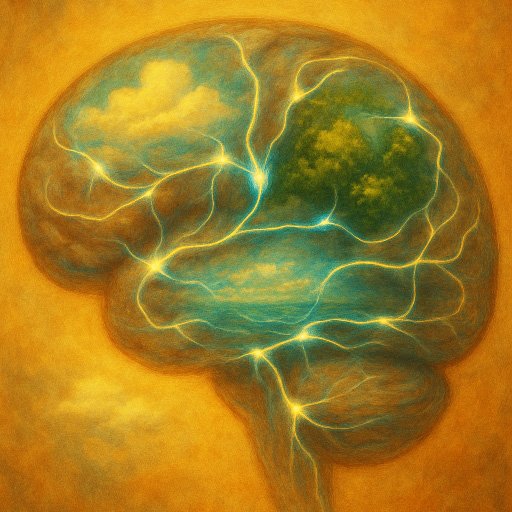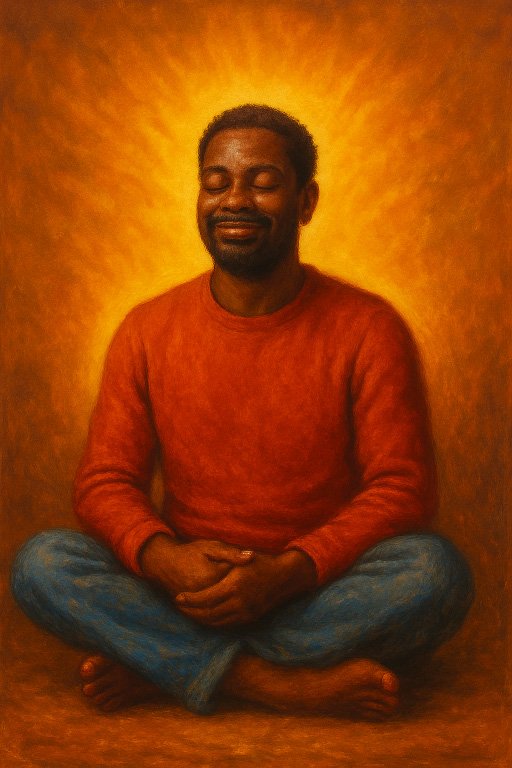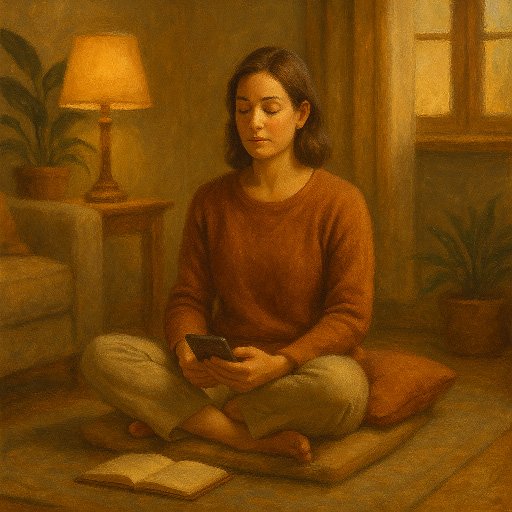Guided Visualization Meditation for Anxiety and Sleep: Complete Guide
Author: Dr. Timothy Rubin, PhD in Psychology
Originally Published: June 2025
Last Updated: June 2025

Guided visualization meditation harnesses the power of imagination to create deep relaxation and reduce anxiety and stress.
Contents
- What Is Guided Visualization Meditation?
- How Guided Visualization Supports Mental Health
- How to Practice Guided Visualization: Step-by-Step
- Effective Visualization Techniques for Different Needs
- Digital Tools and AI for Guided Visualization
- Tips for Successful Guided Imagery Practice
- Getting Started with Visualization Meditation
- FAQ: Guided Visualization Meditation
Guided visualization meditation for anxiety and sleep, also known as guided imagery, is a relaxation practice that harnesses the power of your imagination to improve your mental well-being. Think of it as directed daydreaming for a purpose – usually to reduce stress, ease anxiety, or help you fall asleep.
In a guided visualization meditation, you either listen to someone (or an audio recording) walk you through a peaceful scenario, or you guide yourself through it mentally. Instead of focusing on your breath or a mantra like in traditional mindfulness meditation for anxiety, you give your mind a vivid scene or story to engage with. By doing so, you gently redirect your thoughts away from worries and into a calmer, safer mental space.
What Is Guided Visualization Meditation?

Research shows that the brain responds to imagined experiences almost as if they were real, triggering genuine relaxation responses.
What's amazing is how the mind responds to imagined experiences almost as if they were real. If you vividly picture biting into a sour lemon, for instance, your mouth might actually water or pucker – even though there's no lemon. Similarly, when you immerse yourself in a guided meditation for insomnia featuring a tranquil beach at sunset, your body begins to relax as if you're truly there.
Heart rate and blood pressure can drop, muscle tension eases, and stress hormones decrease. Research has found that guided imagery can produce an immediate relaxation response and significantly improve anxiety symptoms, even boosting the overall quality of life for people with anxiety disorders.
The Science Behind Visualization Meditation
Your brain's imagery and emotional centers are closely connected, so when you feed calming, positive images into the mind, you tend to get calming, positive feelings out. This makes visualization meditation techniques for stress relief particularly effective because they engage multiple areas of the brain simultaneously:
- Visual cortex: Processes the imagined scenes and images
- Emotional centers: Respond to the feelings evoked by the imagery
- Nervous system: Triggers the relaxation response throughout the body
- Memory centers: Store positive associations for future stress relief
How Guided Visualization Supports Mental Health

Guided visualization offers a way to step out of racing thoughts and into a mental "safe haven" for anxiety relief.
One of the biggest benefits of guided imagery meditation is how versatile it is. Different visualizations can be tailored to different needs, making it an excellent complement to other approaches like CBT techniques for anxiety or daily habits that reduce anxiety.
Anxiety Relief Through Imagery
For anxiety relief, guided visualization offers a way to step out of the racing thoughts and into a mental "safe haven." Many people with anxiety find it hard to meditate by just clearing the mind, because the worry thoughts keep intruding. But if you give your mind a job – e.g. "imagine you're walking through a peaceful meadow" – it has something to do, something gentle to focus on.
The vivid details occupy the mind: the sound of birds, the feel of warm sunlight, the smell of grass. As you engage the senses in this imaginary environment, there's less room for anxious thoughts to take over. Studies have indicated that even a single session of nature-based guided imagery can lower anxiety levels, sometimes even more effectively than generic relaxation without imagery.
Depression and Mood Support
For depression or low mood, guided visualization can offer a spark of positivity or a break from negative thought patterns. Depression often comes with a lot of self-critical or hopeless imagery. Meditation techniques for depression combined with guided visualization can gently replace some of that with neutral or positive imagery.
For example, a guided journey that focuses on climbing out of a dark valley into a bright mountaintop can symbolically instill hope. One clinical trial with patients undergoing dialysis found that those who practiced guided imagery had lower anxiety and depression scores than those who didn't.
Sleep and Insomnia Relief
Guided visualization for sleep has become a go-to tool for many insomnia sufferers. When you lie down at night and your brain won't stop chattering, doing a visualization is like telling a bedtime story to your mind. Instead of it spinning worries, you purposefully redirect it: "Imagine you're floating on a calm lake, the moonlight dancing on the water…"
This approach works well alongside other meditation techniques for better sleep and sleep hygiene practices. Research with older adults facing surgery showed that those who listened to guided imagery at bedtime significantly improved their sleep quality.
How to Practice Guided Visualization: Step-by-Step

Learning how to do guided imagery meditation is simple and can be practiced anywhere with just a few basic steps.
One of the great things about how to do guided imagery meditation is that it's very user-friendly. You can follow a recorded script or guide yourself once you get the hang of it. Here's a simple approach to try:
Setting Up Your Practice
- Find Your Space: Choose a quiet, comfortable spot where you won't be disturbed. If you're using it for sleep, doing this in bed is perfect. Otherwise, sitting in a chair or lying on a couch works too.
- Get Comfortable: Loosen any tight clothing and close your eyes. This creates the optimal environment for your meditation visualization exercises.
- Begin Relaxation: Take a few slow, deep breaths. Inhale through your nose, and exhale through your mouth, allowing your shoulders and jaw to release tension.
Creating Your Visualization
- Choose Your Scene: Decide on a scenario that feels pleasant and calming to you. If the goal is sleep or deep relaxation, nature scenes often work well (like a beach, forest, or meadow). For anxiety relief before a specific event, you might imagine a positive outcome scenario.
- Start Simple: For beginners, a classic relaxation example is a warm beach at sunset. This setting naturally incorporates multiple sensory elements that are easy to imagine.
Engaging All Your Senses
- Build the Visual: In your mind's eye, start painting the scene. See the colors of the sunset sky – maybe streaks of pink and orange. Notice the gentle motion of the ocean, the way the waves ebb and flow.
- Add Sounds: Hear the rhythmic sound of those waves, maybe the distant call of a seagull or the gentle rustle of palm fronds.
- Include Physical Sensations: Feel the ground beneath you – perhaps your toes are in warm, soft sand, or you're sitting on a comfortable chair with a sea breeze on your skin.
- Incorporate Scents: Smell the salty, fresh ocean air. These sensory details make your guided meditation for insomnia more immersive and effective.
- Immerse Completely: Spend several minutes in this scene. Explore it slowly. You might imagine walking along the shore, feeling the water on your feet, watching the sunlight sparkle on the water.
Effective Visualization Techniques for Different Needs

Different visualization scenes can be tailored to specific needs, from anxiety relief to sleep improvement to confidence building.
The beauty of visualization meditation techniques for stress relief is their adaptability. Here are some proven approaches for different situations:
For Anxiety and Stress Relief
- Safe Place Visualization: Create a detailed mental sanctuary where you feel completely secure and calm
- Nature Scenes: Forest walks, mountain meadows, or peaceful gardens work well for general anxiety
- Protective Imagery: Imagine yourself surrounded by a bubble of light or protective energy
For Sleep and Insomnia
- Progressive Journey: Visualize walking down a path that leads to deeper relaxation with each step
- Floating Imagery: Picture yourself floating on calm water or drifting on a cloud
- Cozy Scenarios: Imagine being in a warm, comfortable cabin during a gentle rainstorm
For Confidence and Performance
- Success Rehearsal: Visualize yourself successfully completing an upcoming challenge
- Strength Imagery: Picture yourself as strong and capable, perhaps climbing a mountain or achieving a goal
- Positive Outcome Scenarios: Mentally rehearse receiving praise or accomplishing something important
These techniques work particularly well when combined with other approaches like cognitive restructuring techniques or mindfulness-based cognitive therapy approaches.
Digital Tools and AI for Guided Visualization

AI-powered tools can create personalized guided visualizations tailored to your specific needs and current emotional state.
While traditional guided visualization relies on pre-recorded scripts or self-guidance, modern AI-powered meditation tools are revolutionizing how we practice visualization meditation. These digital platforms can create personalized experiences that adapt to your specific needs and circumstances.
Benefits of AI-Enhanced Visualization
- Personalized Scenarios: AI can create visualizations based on your specific stressors, preferences, and goals
- Adaptive Content: Adjust the imagery and pacing based on your current emotional state
- 24/7 Availability: Access guided visualizations whenever anxiety strikes or sleep won't come
- Progress Tracking: Monitor which types of visualizations work best for your needs
For example, Wellness AI can generate custom guided visualizations that incorporate your personal circumstances and challenges. Whether you need a visualization for work stress, relationship anxiety, or sleep difficulties, AI can create scenarios specifically tailored to your situation, making the practice more relevant and effective than generic recordings.
These tools are particularly valuable for maintaining consistent practice and exploring different visualization techniques until you find what works best for your unique needs.
Tips for Successful Guided Imagery Practice
While guided visualization meditation is generally straightforward, these tips can help you get the maximum benefit:
Building Your Practice
- Consistency is Key: Like most meditation practices, doing it regularly (even a few times a week) trains your relaxation response to kick in faster
- Start Small: Begin with 5-10 minute sessions and gradually increase as you become more comfortable
- Use Resources: Audio guides from meditation apps, YouTube, or podcasts can provide soothing narration and background music
- Find Your Style: Some prefer very soft, whispery guides, others like a more matter-of-fact tone
Enhancing Your Experience
- Engage Emotion, Not Just Imagery: Focus on how the scene makes you feel rather than perfect visual detail
- Incorporate Breathing: You might inhale and imagine drawing in peaceful energy, then exhale stress
- Add Affirmations: Include positive statements in your scenarios for extra reinforcement
- Be Patient: If your mind is very anxious, it might rebel at first – this is normal and improves with practice
Troubleshooting Common Challenges
- Mind Wandering: Gently bring attention back to the scene without judgment – this is part of the practice
- Difficulty Visualizing: Focus more on feelings and sensations rather than perfect visual clarity
- Skepticism: Trust that your body is getting benefit even if effects seem subtle at first
Getting Started with Visualization Meditation
Guided visualization meditation for anxiety and sleep is a flexible, enjoyable way to tap into your mind's natural calming circuits. Whether you use guided imagery for sleep – conjuring up a safe, dreamy haven each night – or as a quick mental escape during a hectic day, it can become a reliable tool in your mental health toolkit.
Here are the best ways to begin:
For Beginners
- Start with pre-recorded guided visualizations to learn the basic structure
- Practice for just 5-10 minutes initially
- Choose simple, pleasant scenes like beaches or forests
- Focus more on the feeling of relaxation than perfect imagery
Building Your Skills
- Experiment with different types of scenarios and settings
- Try creating your own visualizations for specific situations
- Combine with other relaxation techniques you've learned
- Consider using AI-powered tools for personalized experiences
Remember, guided visualization leverages the fact that our brains respond to imagined experiences much like real ones. So why not intentionally feed your brain some soothing, empowering experiences? As you practice, you may find that your ability to cope with real-world stress improves, because you know you can always find a calm refuge within your own mind.
-Tim, Founder of Wellness AI
About the Author
Dr. Timothy Rubin holds a PhD in Psychology with expertise in cognitive science and AI applications in mental health. His research has been published in peer-reviewed psychology and artificial intelligence journals. Dr. Rubin founded Wellness AI to make evidence-based mental health support more accessible through technology.
FAQ: Guided Visualization Meditation
How is guided visualization different from regular meditation?
While traditional meditation often focuses on breath awareness or clearing the mind, guided visualization gives your mind a specific job—imagining peaceful, detailed scenarios. This makes it easier for people with anxiety or busy minds who struggle with "empty mind" meditation. Instead of fighting racing thoughts, you redirect them into calming imagery, which can be more accessible for beginners.
Can guided visualization really help with sleep and insomnia?
Yes, research consistently shows that guided imagery can improve sleep quality and reduce insomnia. When you engage your mind with peaceful scenarios at bedtime, you're essentially telling your brain a calming bedtime story, which helps shift focus away from worries and activates the relaxation response needed for sleep. Studies with surgery patients and older adults have shown significant sleep improvements with regular practice.
How long should a guided visualization session last?
Sessions can be as short as 5 minutes for quick stress relief or as long as 30-45 minutes for deep relaxation or sleep. For beginners, starting with 10-15 minute sessions is ideal. For sleep purposes, you can let the visualization continue until you fall asleep—there's no need to "finish" the session if you drift off mid-visualization.
What if I have trouble visualizing clearly or my mind keeps wandering?
This is completely normal and doesn't mean you're doing it wrong! You don't need movie-quality visuals in your mind. Focus more on the feelings and general impressions rather than perfect detail. When your mind wanders (which it will), gently guide it back to the scene without judgment. Even rough impressions and frequent mind-wandering can still provide relaxation benefits.
Can I create my own guided visualizations, or should I use recordings?
Both approaches work well! Recordings are great for beginners because they provide structure and allow you to relax completely without thinking about what comes next. Once you're comfortable with the process, creating your own visualizations can be very effective because you can tailor them exactly to your needs and preferences. Many people use a combination of both methods.
Is guided visualization safe for everyone to practice?
Guided visualization is generally very safe and suitable for most people. However, if you have certain mental health conditions like severe PTSD or psychosis, it's best to consult with a mental health professional before beginning practice. Some people with trauma may need modified approaches or professional guidance to ensure the practice feels safe and beneficial.